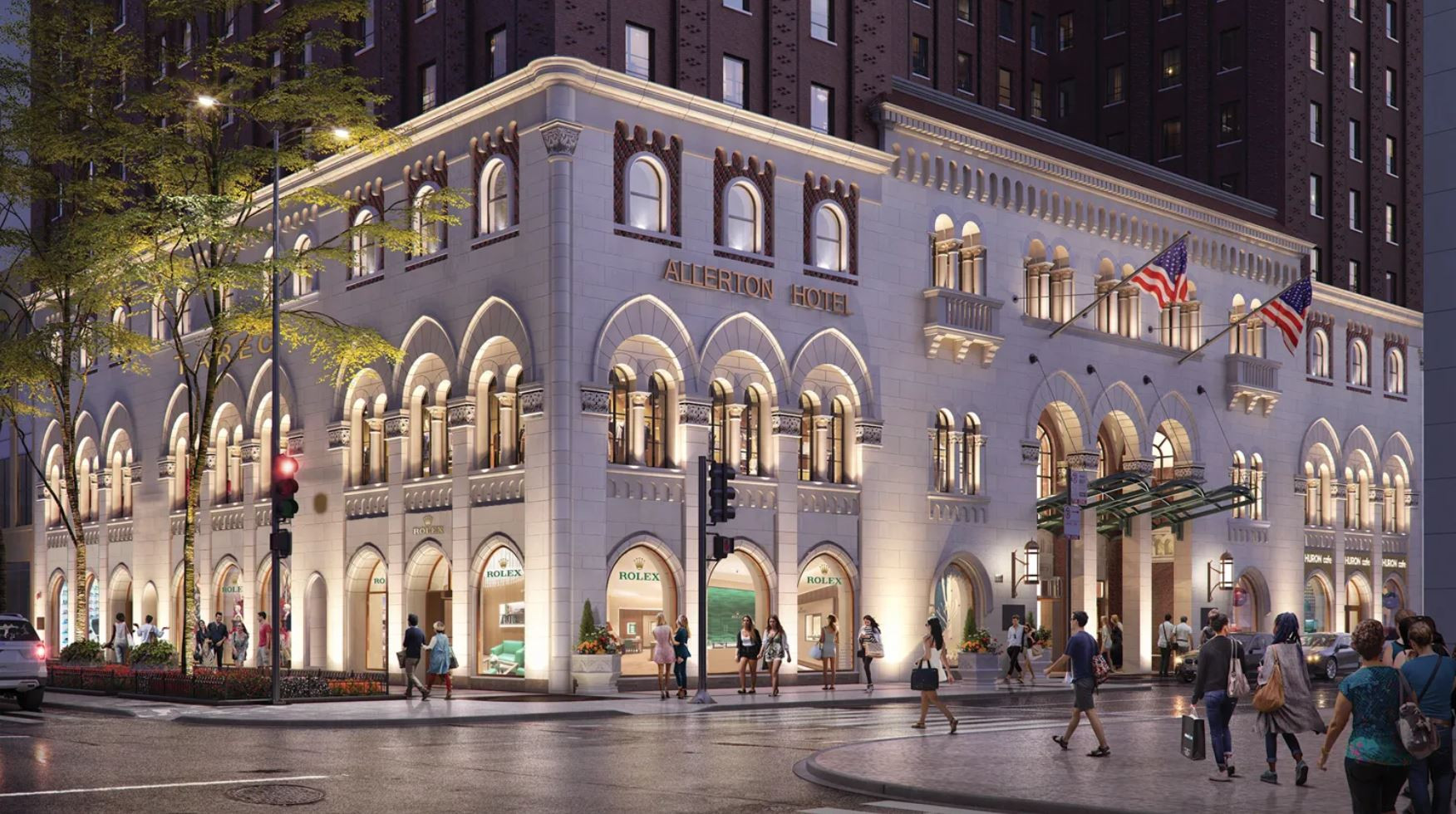Prime-corridor urban retail is poised for an investor resurgence in 2024, underpinned by robust consumer spending and record-low total retail vacancy. These burgeoning fundamentals led asking rents across U.S. prime urban retail corridors to grow 3.3% from 2022 to 2023, according to JLL’s City Retail 2024 report. Consumer spending continues to grow, retail vacancies are getting tighter and international and business travel is on the rebound, supporting optimism for further investment activity on high streets.
Sales of prime urban retail corridor property dropped 39% to $4.8 billion in 2023, driven by a decrease in large-scale deals and by a comparison to 2021 and 2022’s unusually high levels of investment. The drop in large deals, both portfolios and individual properties, owed in part to turbulence in the debt market.
The 39% decline still was smaller than the drop in sales in each office, industrial, hotel and multifamily. This resilience may owe to investors seeking stable income streams backed by strong consumer demand. While challenges remain, the fundamental strength of prime-corridor urban retail could indicate potential for growth.
Investment activity is expected to accelerate over the next 12 to 18 months as the likelihood of interest rate cuts this year grows and as private equity fund lives expire. Billions in securitized debt in prime urban retail corridors will mature over the next three years, and as it does, that financial stress will transform to optimism, clearing the way for strong investment activity to continue.
The transactions already are ramping up. This month, Grosvenor sold 701 N. Michigan Ave., a 22,900-square-foot retail condo at the base of the Magnificent Mile’s Warwick Allerton - Chicago hotel to Mason Asset Management and Namdar Realty Group. “There is a growing sentiment that the window to buy assets like this is closing,” said Keely Polczynski, JLL Capital Markets managing director, which represented the seller.

At Chicago’s 701 N. Michigan Ave., Rolex started a long-term lease two years ago of 2,240 square feet of ground-floor retail and 2,040 square feet of basement storage. The property has three vacancies and available basement storage.
Luxury brands also are buying. Paris-based conglomerate LVMH is in discussions to purchase space occupied by a Bergdorf Goodman men’s store on Manhattan’s Fifth Avenue, according to The Wall Street Journal, and other acquisitions by retailers have closed on that corridor recently.
Urban retail investment activity isn’t confined to gateway markets, either. Capstone Advisors acquired 420 and 501 S. Mill Ave., near Arizona State University and live sports and entertainment venues, for $22.2 million. Built in 1998, the properties’ combined 38,896 square feet are fully occupied. The city of Tempe recently announced a $22 million streetscape improvement plan for Mill Avenue, and Capstone plans to renovate the assets to elevate their visibility.
Investment Brokerage CEOs Predict Busy Second Half of 2024

Commercial property brokerage firms are prepping for a recovery in the second half of 2024. CBRE, Colliers and now Marcus & Millichap have projected that commercial real estate deal activity will pick up later this year. Executives for the companies expressed optimism that the Federal Reserve will cut interest rates and that credit conditions will improve.
For now, deal activity remains muted after one of the most challenging years on record. CBRE said revenue from commercial property sales in the Americas fell 22% in 2023. “Investor and lender sentiment has improved, and we anticipate this will lead to increased transaction volumes, starting in the second half of the year when short-term interest rates are expected to fall,” said CEO Bob Sulentic.
Colliers, too, felt the impact of high interest rates on transactions. “Throughout the year, we observed industrywide declines in transaction volumes, which had an impact on our capital markets,” said CEO Jay Hennick. “However, we anticipate a return to higher transaction velocity in the latter half of 2024 as interest rates and credit conditions stabilize.”
Marcus & Millichap sales transaction volume fell 30.8% in 2023, and a higher number of properties took multiple contracts to close, according to president and CEO Hessam Nadji. “The eventual Fed shift, coupled with growing evidence of an economic soft landing will become catalysts to an increase in transactions and release of pent-up demand held by investors waiting for clarity,” he said. “With record capital on the sideline, as values adjust, we are seeing more buyer activity and offers on well-priced inventory we are bringing to market.“
REITs Have Entered the Starting Gates, Ready for Sellers to Start the Race

REITs are planning to snap up prime properties and redevelopment opportunities as soon as owners list them for sale, executives said on year-end earnings calls.
“We are looking forward to a good year in 2024 for acquisitions,” said Federal executive vice president and chief investment officer Jan Sweetnam. “2023 was a record year for sellers asking brokers for their broker opinion of values,” he said, and most of those sellers chose not to put their properties up for sale until the cost of capital and cost of debt declined. “We’re hearing a lot of rumbling about sellers now putting their properties on the market.” Federal plans to acquire infill properties in 2024 via structured investment deals with private sellers and older sellers that have owned their properties for a long time.
A growing number of grocery-anchored centers are being marketed, REIT executives said. “We’re definitely seeing a little pickup,” said Regency Centers chief investment officer and West region executive vice president Nick Wibbenmeyer. “We’ve turned the page now into 2024. We are seeing more activity out there. It’s still below historical norms but definitely a pickup from 2023.” The REIT plans to use its balance sheet to help smaller developers finance construction, he added. “Many times, they need more than just debt capital. They need expertise. They need relationships to fix their cash-on-cash returns. And so debt and equity is in play in those conversations.” Regency recently closed a deal providing senior and mezzanine debt on a potential future acquisition with redevelopment opportunities, he said.
Kimco Realty, meanwhile, could be a net seller as it offloads noncore properties from its recent acquisition of RPT Realty. “We aim to sell between $250 million to $350 million of former RPT centers at a blended low- to mid-8% cap rate,” said president and chief investment officer Ross Cooper. The REIT will continue to focus its investments on off-market and grocery-anchored shopping centers. Looking beyond direct ownership, Kimco sees potential to provide preferred equity and mezzanine financing on high-quality properties, he added.
The Tenant Types Where Visits Increased the Most Last Year
Consumers focused on wellness and on value on their shopping trips in 2023, according to Placer.ai. Visits to fitness venues increased by 14.7%. Among those that Placer.ai tracked, Crunch, which steadily has expanded its store fleet, drew the largest growth in visits, at 28.2%.
Beauty and self-care venue visits rose 10.3%, discount store and dollar store visits 8%, grocery store visits 4.4%, superstore visits 3.7% and dining venue visits 2.1%.
Starbucks’ Inclusive Spaces Framework
Starbucks unveiled new guidelines for store layouts and operations to enhance ease of use for all customers and employees, including those with disabilities. Some of the features:
- power-operated doors
- wider pathways with clear signage
- lower counters
- open sightlines
- designated quiet areas
- status boards for customer orders
- intuitive point-of-sale systems with screen magnification and voice assist
- optimized acoustics and lighting to aid communication
- larger buttons on brewing equipment
The first store built using inclusive design opened Feb. 16 in Washington, D.C.’s Union Market, and Starbucks will apply the accessibility design framework to all new and renovated company-operated stores in the U.S. Existing company-owned stores gradually will update to include these features. The coffee chain, which owns some 16,000 units in the U.S., plans to grow that base by 4% this year.

Starbucks’ new store in Washington, D.C.’s Union Market is designed based on the company’s new inclusivity guidelines.
Shops and Cafes Backfilling Office?
As many office buildings stand half empty or entirely vacant, a trend is emerging: transforming underutilized properties and places into shops, restaurants and other businesses. This “adaptive reuse” is even getting a boost from some cities that are changing zoning rules to make it easier, according to a recent Colliers report.
“The future of office … may involve mixed-use developments with hospitality, residential, office and retail components activated 24/7 through conversions and the addition of amenities like museums, entertainment and experiential-use spaces,” said Colliers U.S. director of retail services and practice groups Anjee Solanki.
Bringing in retailers also could lure new office tenants seeking amenities like cafes and shops right downstairs, explained U.S. office agency leasing head Michael Lirtzman.
Cities like Arlington, Virginia, are ahead of the curve. Officials there have expanded the types of businesses allowed in offices, welcoming unique concepts like breweries, dog boarding facilities and medical services. The way people use offices has fundamentally changed with hybrid work, Arlington Economic Development director Ryan Touhill told C+CT in December, adding: “We recognize this problem, and we are working very proactively to try to figure out how to help owners reposition their buildings and how to find tenants that want to be in this market. We need to rethink our downtown and our urban business districts.”
By Brannon Boswell
Executive Editor, Commerce + Communities Today